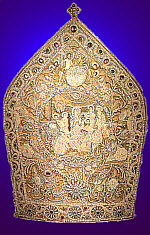There
are other churches of Armenian Christianity, including
Roman Catholic and Protestant, but by far the largest congregation is
the Armenian Apostolic Church. It is one of two main branches of Christianity
divided between Chalcedonian and Non-Chalcedonian churches. These are
subdivided between the Western Orthodox (Greek, Russian, Serbian and Macedonian),
Roman Catholic and Protestant Churches, and the Oriental Orthodox churches
(Armenian Apostolic, Syrian, Coptic and Indian Malabar).
The main difference between the branches is in how they treat the nature of Christ, did he come to earth in both human and divine form, or in one form only, both human and divine? This seems to be pulling at straws, but in its day it was a reason for schisms between the Greek Orthodox and the Roman Catholic churches, and before that, the schism between the Armenian Apostolic and Greek Orthodox churches. The argument precipitated divisions in the Empire, and was an excuse for many a war. The Armenian Apostolic Church accepts the latter view, thereby being a Monotheist or "Monophysism" church.
The relationship between these branches is best described in terms of their patriarchal structure. Armenians prefer to call the relationship between the Roman Catholic Pope and the Katoghikos as equal, but add that the Pope is considered "first among equals," a lesson in diplomacy if ever there was one. When the Pope and the Katoghikos ceremonially meet, they are always seated on equal levels, and there is close contact between the two churches.
The use of statues never took root in the Armenian Church, except for the cross. Frescos were a part of all church décor, often covering entire interior surfaces. The earliest frescos directly influenced Byzantine fresco art, and through it the Romanesque and early Italian fresco tradition. Records show that Armenian artists were lent to Byzantine and Italian courts as early as the mid 4th century. The worship of Astvatsatsin (The Mother of God) assumed greater importance beginning in the 7th-9th centuries and is now a feature of all church altars.
Those acquainted with pre-Vatican II Roman Catholic or Oriental Orthodox services will have some understanding of the rituals. Chanting and polyphonic music make up much of the background to the ritual, which is accompanied by heavy doses of incense and closing the curtain during Eucharist. High services are up to three hours long.
In most of the Armenian churches there are no benches or seats, though Echmiadzin does have seats up front (reserved for dignitaries and some foreigners--feel free to take a seat if you are invited).
Considered disrespectful in churches is placing your hands in your pockets, or standing in a way that can seem casual. Women should wear headscarves, and outlandish clothes or shorts are frowned upon (indeed, older members of a congregation may be quite vocal in admonishing incorrect dress or behavior). It is traditional to walk backwards out of the church (i.e. not to turn your back on the image of God). Candles are sold (25AMD, 50AMD, 100AMD, 200AMD depending on size of candle) inside the church, and large stands are placed in front of particularly holy spots or paintings. Feel free to purchase and light candles if you wish.
During services the more devout will repeatedly bow and cross themselves, sometimes crying out during a service in prayer or anguish. Be respectful of their privacy, and under no circumstances should you attempt to take pictures of this--church members will escort you from the church for doing so.
Do not take flash pictures or use equipment that makes a lot of sound (i.e. automatic wind devices) during a liturgy service. However, at weddings and baptisms locals are notorious for flash pictures and video taping. If you are present when one of these ceremonies is performed, be surreptitious in your picture taking, but often you will be invited to join in, as Armenians feel a foreigner’s presence lends an extra polish to their celebrations.
The Armenian Apostolic Church

Church Etiquette